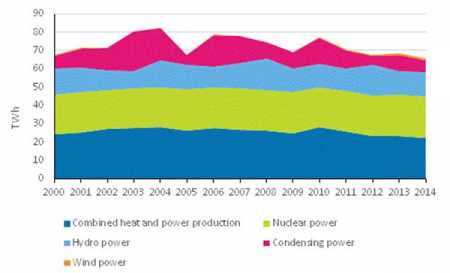|
Fri, 30 Oct, 2015 12:05:46 AM FTimes Report, Oct 30  Production of electricity by production mode in 2000 to 2014. Source: Statistics on production of electricity and heat, Statistics Finland and Electricity statistics, Finnish Energy Industries. Electricity production declined by four per cent in 2014 from the previous year and hit its lowest level in the 2000s, according to Statistics Finland.
The production of electricity in Finland amounted to 65.4 terawatt hours (TWh) in 2014.
Production of district heat and industrial heat also decreased slightly in the year.
The use of renewable fuels decreased by one per cent in the production of electricity and heat. The use of fossil fuels also diminished, as 24 per cent less hard coal and 14 per cent less natural gas was used than in 2013.
By contrast, the use of peat increased by seven per cent as per the data derived from the statistics on the production of electricity and heat.
The electricity production went down by four per cent from the year before. In turn, total electricity consumption went down by one per cent and amounted to 83.4 TWh.
Of total electricity consumption, 78 per cent was covered by domestic production and 22 per cent by net imports of electricity from the Nordic countries, Russia and Estonia.
Net imports of electricity grew by 14 per cent from the year before. Imports of electricity from the Nordic markets increased by nearly 50 per cent as the water situation was better than in 2013.
Thirty-four per cent of domestic electricity production was based on combined heat and power production in 2014.
Thirty-nine per cent of the total production of electricity was covered by renewable energy sources and 21 per cent by fossil fuels.
Thirty-five per cent of electricity was produced with nuclear power and five per cent with peat. Over one-half of the electricity produced with renewable energy sources was produced with hydro power and almost all of the remainder with wood, the data show.
The production of district heat totalled 34.3 TWh in 2014. The production went down by one per cent year-on-year. The use of renewable fuels in the production of district heat grew by seven per cent from the year before.
One-half of district heat was produced with fossil fuels, whose use fell, however, by six per cent from one year ago. District heat was produced most with wood fuels, coal and natural gas.
The production of industrial heat was 52 TWh in 2014.
The production went down by one per cent from the year before. Over 70 per cent of heat produced by industry for its own needs was based on renewable fuels as per the statistics.
The biggest user of industrial heat is the forest industry, which uses its own fuels in production, like black liquor and other wood fuels.
In the chemical and metal industries, part of the use of heat is considered as direct fuel use, and is thus not visible in the production figures on heat.
The statistics on the production of electricity and heat cover almost the entire production of electricity connected to the grid.
Electricity and heat production by production mode in 2014
1) In calculating total primary energy used, hydro power, wind power and net imports of electricity are made commensurate with fuels according to directly obtained electricity (3.6 PJ/TWh). Total nuclear energy used is calculated at the efficiency ratio of 33 per cent from produced nuclear power (10.91 PJ/TWh). Source: Statistics on production of electricity and heat, Statistics Finland and Electricity statistics, Finnish Energy Industries. More News
|
|
Finland Times
| Monday, 29 December, 2025 |

